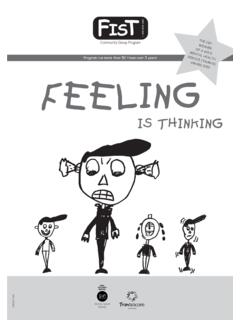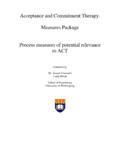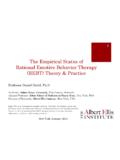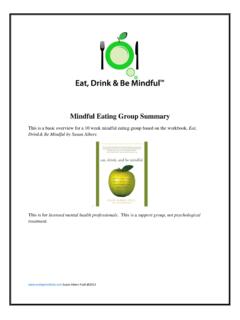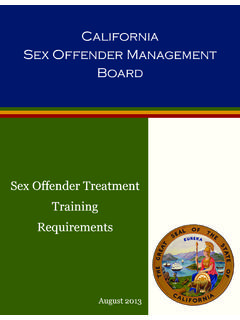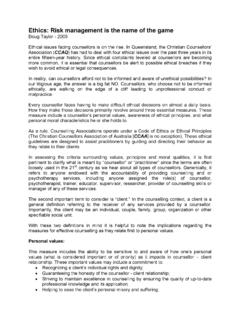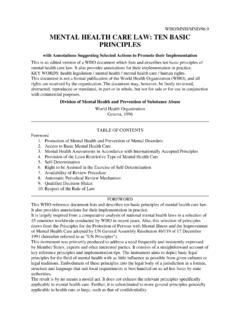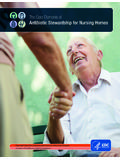Transcription of The therapeutic use of games - DVRCV
1 The therapeutic use of games in groupwork when, why, and how to use them Includes a section on training games for mental health, welfare and education professionals Naomi Audette and Wendy Bunston The Royal Children's Hospital Mental Health Service, Victoria The therapeutic use of games in groupwork Naomi Audette and Wendy Bunston The Royal Children's Hospital Mental Health Service, Victoria The therapeutic use of games in groupwork RCH MHS 2006 1. The therapeutic use of games in groupwork All information and data (including graphics) is provided by The Royal RCH MHS 2006 Children's Hospital Mental Health Service ( RCH MHS) and unless otherwise noted is copyright of RCH MHS. Published by The Royal Children's Hospital Mental Health Service, Disclaimer: The Royal Children's Hospital Mental Health Service Victoria, Australia, January 2006. does not claim ownership or authorship of all the games noted in ISBN XXXXXXXX this manual, but recognises that the majority of the games cited are already used widely within the general population and may be Copyright The Royal Children's Hospital Mental Health Service, a derivative, or replication of existing games with a variation in the Victoria, Australia, 2006.
2 Name, rules or descriptions given. The Royal Children's Hospital Mental Health Service welcomes use of Note: Any monies raised by the sale of this book are immediately this publication within the constraints of the Copyright Act, 1968 and fed back into the service delivery programs of The Royal Children's provided acknowledgment is made to the source. Hospital Mental Health Service. Requests and inquiries for reproduction may be directed in writing to: Further information about the Community Group Program is available The Manager, Community Group Program online at: The Royal Children's Hospital Mental Health Service 50 Flemington Street, Flemington, Victoria 3031. or at 2 The therapeutic use of games in groupwork RCH MHS 2006. About the authors Naomi Audette BA (Psych) GDMD, DDT, professional member IDTIA, DTAA is a dance movement therapist currently completing her masters research. She specialises in developing and running dance movement group therapy interventions with children and adolescents with a range of mental health issues at the RCH MHS Community Group Program and AFVP (Addressing Family Violence Programs).
3 Naomi draws on her wealth of experience and creativity as a dancer, performer and Clown Doctor ( Dr Polly Waf e') to engage and play with clients and train professionals. Wendy Bunston BSW, MaFamTher, is manager of the RCH MHS Community Group Program and the RCH MHS. AFVP and is currently undertaking further tertiary studies in organisational dynamics. She has specialised in working with children and adolescents considered at high risk' and has published in the areas of child protection, childhood trauma, child / adolescent sex offending and specialist groupwork interventions. She is also in great demand as a trainer and public speaker. Also contributing games to this manual has been: RCH MHS. Peta Millard (social worker). Tara Pavlidis (social worker). Paul Leyden (psychiatric nurse). Travancore School Stephanie Shanahan (teacher). Amity Czechowski (teacher/social worker). Tracey Cole (teacher). The therapeutic use of games in groupwork RCH MHS 2006 3.
4 Contents Introduction Foreword About us 7. 6. The CGP. Introduction 8. Using this manual Using games in groupwork 8. It's how you play the game Why we play 9. Recognising the importance of play Issues to consider 10. Groups when running groups 1. Group logistics 10. Group size Group length Age of participants Con dentiality (and its limitations). Competitive games 2. Group stages 10. Warming Forming Storming Norming Performing Mourning Transforming 3. Dynamics of individual sessions 12. Warm-up Release of energy Theme Bringing it all together Closure 4. Space considerations 13. Circle formation Line formation Cluster formation Dispersement formation 4 The therapeutic use of games in groupwork RCH MHS 2006. games 1. Group starters 14. Partner games Sumo wrestlers 46. 47. Name games 15. Mirroring 47. My name is' game 16. Movement conversation 48. Circle name and action 16. Tree exercise 48. Name addition 17.
5 Partners ball game 49. Name game 17. Four corners 49. Name zap 18. Mexican wave 19 Feelings games 50. Name tiggy 19 Character walking 51. Pump up the volume 51. Getting to know you' games 20. Charades 52. Balloon game 21. Angry animals 52. Postcards 21. Feelings statues 53. Get to know you' action game 22. Rolling introductions 22 Trust games 54. Who are you? 23 Trust exercise 55. Truth is stranger than ction 23 Cat and mouse 56. Blindfold walk 56. Warm-up games 24. Partner balance 57. Clap 25. Puppet sculpture 57. Poison ball 25. Musical chairs 26 Personal space games 58. Scarecrow tiggy 26 Filling the space 59. Indians and tepees 26 Human traf c jam 59. Duck, duck goose 27 Personal space circle 59. Fruit salad 27 Relaxation games 60. Dead sh 61. 2. Group games 28 Body relaxation 62. Team building games 29 Rag dolls and tin soldiers 63. Follow the leader 30 Group closure games 64. Warm-up machine 30 Huh!
6 65. Chain chasey 31 Pass the parcel 66. Footy frenzy 31 Dice game 66. Ball on material 32 Graf ti sheets 67. Pass the hoop 32. Group stop / start 33 3. Training games Communication games 34 for professionals 68. Wink circle 35. Ice breakers 69. Wink murder 35. Bingo bee 70. Wandering whispers 36. Sixty second sell 70. Group storytelling 36. Name game 71. Taking a stand 37. Life is like a box of chocolates 72. Chants 37. Time lines 73. Problem solving games 38 Energy boosters 74. Object memory 39 Farmyard 75. Group knot 39 Streets and lanes 76. Magazine mix up 40 Treasure chest 76. Changes 40. Exploring themes 77. Who am I? 41. Attunement chopsticks 78. Back to back 41. Graf ti sheets 78. Impulse control games 42 House of cards 79. What's the time Mr / Mrs / Ms Wolf? 43. Spy treasure 43. Ship ahoy! 44 Concluding comments 80. Shop til you drop! 44 Resources 81. Musical statues 45 Further reading 81. Yoga freeze 45.
7 The therapeutic use of games in groupwork RCH MHS 2006 5. Foreword Groups are a tremendously It is in groups of various kinds that Much attention has been paid to this important part of human life. we live our lives: family groups, peer aspect of playing and learning in groups groups, social groups, work groups. In in this manual, in order to create the Human beings are social each we learn to play, and play to learn. right atmosphere in which children, beings. Relating to one another The child playing on their parents' knee young people, families and professionals is a vital part of peoples' learns about relating, turn taking, about can gain from their experiences. lives. Group acceptance and being enjoyed, valued and loved. The acknowledgment provide a sense children playing house and school are This games manual is the outcome of of connectedness, which is an learning about adult roles, and trying a tremendous collaboration of all the members of the Community Group immensely nourishing experience.
8 To understand the world in which they live. Groups of families playing together Program, both past and present. It show their children how to co-operate represents several hard years of work and collaborate and be appreciated; how and play. The interventions they to cope with, and make the most of have developed have been subject to differences. Groups of children playing continuous evaluation, with objective together are learning how to be creative measures where this is possible, to show together, solve problems together, how that they do bene t the young people. to cope with excitement and jealousy, Behind the apparent simplicity, is an and how to get on with others. Adults enormous amount of careful thought, at work may play around with ideas', discussion, and experience of running or undertake what they do with a sense these groups to ensure that they work of playfulness. and that they are effective at helping clients with the problems they are Playing in groups is a potent part of struggling with.
9 Our learning: we learn from each other. games create a structure, which harness I would like to congratulate the writers ideas and provides a focus for learning. and the members of the Community This selection of games covers a wide Group Program for this manual, and range of opportunities from which am con dent that anyone running children and adults can play and learn. therapeutic groups will nd this manual an invaluable resource. Bowlby (1969) 1 showed that a secure attachment is essential for con dent exploration of the world; it creates a sense of safety that allows the child to notice and to learn, instead of feeling Dr Bob Salo constantly anxious and worried. MBChB, MRCP sych Clinical Director The Royal Children's Hospital Mental Health Service 1. Bowlby, J. (1969). Attachment and Loss: Volume 1. Attachment. Basic Books: New York. 6 The therapeutic use of games in groupwork RCH MHS 2006. About us The Community Group The CGP 's aim is to bring mental socially isolated and unable to Program (CGP), is a health services to children (aged 1 15) form friendships and their parents within their own collaborative mental health and having poor impulse control, school and / or local community.
10 Education department initiative aggression and anger issues Running imaginative, exciting and that commenced in early 1999. relevant groupwork interventions, struggling to demonstrate respectful Since its inception the CGP has the CGP provides non-stigmatising attitudes / beliefs regarding sexuality. developed and evaluated over mental health assistance to children The mental health members of the 20 different types of groupwork at emotional, psychological, and CGP also provide speci c specialist interventions. These therapeutic familial risk, in a non-threatening interventions to infants, children and groupwork programs have been and accessible manner. families affected by severe family delivered over 400 times in The focus of our programs is to address violence. The RCH MHS Addressing schools, community health and a range of emotional, psychological, Family Violence Programs (AFVP). mental health settings across behavioural and social issues that may be consists of groupwork interventions, Western and North Western inhibiting the well-being and self-esteem the production of educational products and the delivery of speci c training and metropolitan Melbourne.

